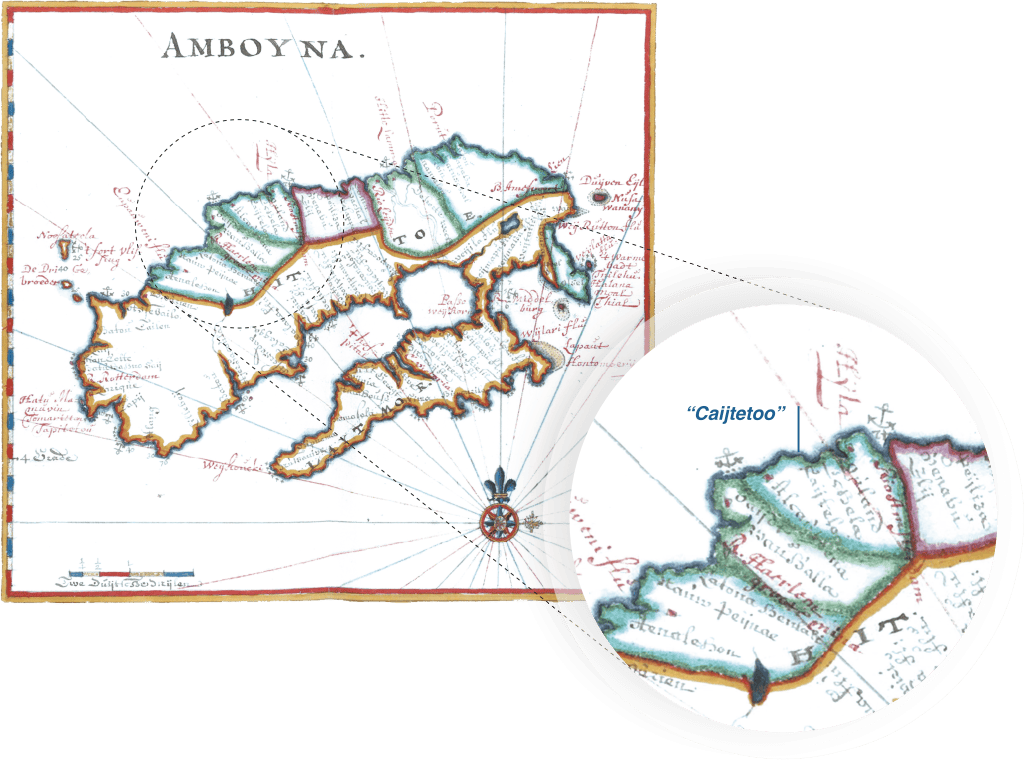
Maluku’s involvement in the spice trade, mostly nutmeg and cloves, began before the arrival of Europeans. Ceramic shards from China, Vietnam, and Thailand, dating between the 13th and the 15th c., are among the numerous pieces of evidence proving Maluku’s early participation in the global exchange.
However, these interactions took a new impetus with the arrival of Europeans in the early 16th c. The Portuguese and the Spanish were the first Europeans involved, but they were quickly replaced by the Dutch who controlled this lucrative trade from the 17th c. onwards.
This dynamic exchange, which also brought Christianity to the region, soon spawned resistance from local communities, including populations in the Wawane mountains, the ancestral homeland of the people of Kaitetu. This conflict, which lasted about 20 years, came to be known as the Great War of Tanah Hitu.
At the beginning of this war, it is said that the Old Mosque (now the Wapauwe mosque) was moved 6 km away from Wawane, to another nearby mountain site in Tehala.
In collaboration with other local kingdoms, the Dutch won the war in the second half of the 17th c., and, as a result, controlled the whole of Ambon Island.
Certain highland communities, like the Uli Hatunuku, who later formed the Kingdom of Kaitetu, were asked to relocate to coastal areas to simplify governance and oversight. In the case of Kaitetu, the old mosque was still located in Tehala in 1664. However, according to the Raja and the elderly today, it was brought downhill “overnight, along with all its equipment.” This local legend is likely to hold truth, considering the distinct “knock down” technique used in the Wapauwe mosque, in combination with its natural bindings.
Perched on the summit of Mount Wawane in Kaitetu Village, the Wawane Fortress stands as a timeless testament to the Maluku people’s fight for freedom.
Like the Kapahaha Fortress, it was constructed around the 17th century by Captain Kakiali of the Hitu Kingdom, these natural fortresses served as the heart of the local defence system.
While the original materials have disappeared over time, the four cannons and the stone table (dolmen) where war leaders once convened remain, echoing the fortress’s vital role as a command centre.

Kaitetu was once affiliated with the Kingdom of Hitu or Tanah Hitu, a kingdom that holds historical significance for its pivotal role in the dissemination of Islam in Ambon and the broader region in the 14th century. This connection reveals strong ties to Java as a center for Islamic learning and could partly explain the unique Javanese features of the Waupaue mosque. A famous local chronicle, the Hikayat Tanah Hitu (History of Tanah Hitu) mentions four missionaries, one of whom studied Islam in Java. Oral tradition also mentions Gresik, Tuban and Jepara as centers of learning. Furthermore, there are ancient Qurans and manuscripts, preserved in the Hatuwe clan house, that attest to Kaitetu’s role in the propagation of Islam in the region. There is also a valuable assortment of historical artifacts and manuscripts kept within the mosque. This collection includes a khutba text for Id al-Fitr prayers and a Qur’an manuscript dated to 1590, which was transcribed by Nurcaya, a student of Imam Rajali.

Kaitetu was once affiliated with the Kingdom of Hitu or Tanah Hitu, a kingdom that holds historical significance for its pivotal role in the dissemination of Islam in Ambon and the broader region in the 14th century. This connection reveals strong ties to Java as a center for Islamic learning and could partly explain the unique Javanese features of the Waupaue mosque. A famous local chronicle, the Hikayat Tanah Hitu (History of Tanah Hitu) mentions four missionaries, one of whom studied Islam in Java. Oral tradition also mentions Gresik, Tuban and Jepara as centers of learning. Furthermore, there are ancient Qurans and manuscripts, preserved in the Hatuwe clan house, that attest to Kaitetu’s role in the propagation of Islam in the region. There is also a valuable assortment of historical artifacts and manuscripts kept within the mosque. This collection includes a khutba text for Id al-Fitr prayers and a Qur’an manuscript dated to 1590, which was transcribed by Nurcaya, a student of Imam Rajali.